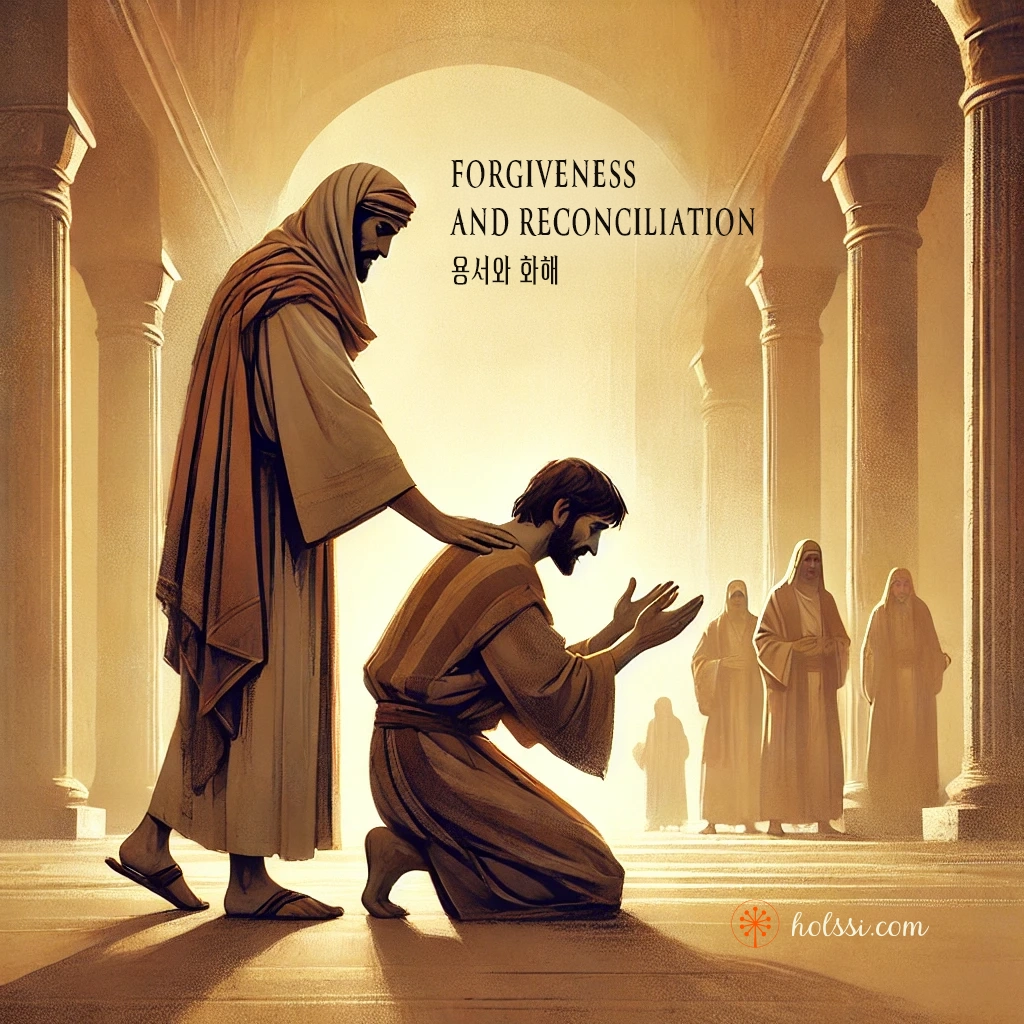Boundless Grace, Boundless Forgiveness

1. Introduction / Theme Presentation
Dear brothers and sisters in Christ, as we go through life, we inevitably encounter conflicts and hurts of varying degrees. Sometimes these wounds run so deep that relationships break down. In such moments, questions arise: “Can I truly forgive that person?” “Is reconciliation even possible?”
In Matthew 18:21–35, Jesus clearly teaches what forgiveness and reconciliation entail and why we must practice forgiveness toward one another. Having received God’s immense forgiveness, how are we called to mend our relationships with others? Let us explore this together through today’s passage.
2. Scripture Reading and Exposition
Scripture: Matthew 18:21–35
Peter’s Question (vv. 21–22)
- Peter approaches Jesus and asks, “Lord, how many times shall I forgive my brother or sister who sins against me? Up to seven times?”
- Jesus replies, “I tell you, not seven times, but seventy-seven times” (v. 22, NIV). Essentially, Jesus is saying, “Forgive without limits.”
The Parable of the Servant Who Owed Ten Thousand Talents (vv. 23–27)
- Jesus tells the story of a servant who owed his king ten thousand talents—an enormous debt that no ordinary person could repay in a lifetime.
- Shockingly, the king completely forgives this massive debt.
- This illustrates God’s unconditional and boundless grace and forgiveness toward us, emphasizing the incalculable debt we owe yet have been forgiven.
The Servant Who Fails to Forgive His Fellow Servant (vv. 28–30)
- Despite having his enormous debt forgiven, the same servant encounters a fellow servant who owes him a hundred denarii—a comparatively small amount.
- He violently demands repayment, and when his fellow servant cannot pay, he has him thrown into prison, refusing any mercy.
The King’s Judgment (vv. 31–35)
- On hearing this, the king rebukes the unforgiving servant: “I forgave you all that debt. How could you fail to forgive your fellow servant?”
- The king punishes him accordingly. Jesus concludes with a sobering warning: “This is how my heavenly Father will treat each of you unless you forgive your brother or sister from your heart” (v. 35, NIV).
3. Doctrine / Truth
God’s Infinite Grace and Forgiveness
- Because of sin, we owed God a debt we could never repay. Yet through Jesus Christ, God canceled our entire debt (Romans 5:8).
- “But God demonstrates his own love for us in this: While we were still sinners, Christ died for us” (Rom. 5:8, NIV). This demonstrates a love and grace that surpass our understanding.
A Believer’s Forgiveness: Passing On the Grace Received
- In the parable, the servant who had been forgiven ten thousand talents failed to forgive a fellow servant’s minor debt. He did not comprehend the enormity of the mercy he had received.
- If we, as believers, have truly experienced God’s immense love and forgiveness, we are compelled to share the same heart of compassion with our neighbors and within our community (Ephesians 4:32).
Forgiveness as the Key to Restoring Community
- When relationships are broken, forgiveness must come first. It is through forgiveness that hearts are restored, and the church community can unite in love and reconciliation (Colossians 3:13–14).
4. Explanation, Illustration, and Argument
A Real-Life Example of Forgiveness: The Amish Community
In 2006, a tragic shooting occurred at an Amish school in Nickel Mines, Pennsylvania. The perpetrator, Charles Roberts, invaded the school, shot several young students, and then took his own life. Five children lost their lives, and several others were injured.
In the aftermath, the response of the Amish community stunned the world. Despite their immense grief and shock, they reached out to the gunman’s family to comfort them, attended his funeral, and declared, “We forgive you.” They even set up a fund to help alleviate the emotional and financial burdens on the killer’s family.
Major news outlets such as The New York Times covered the story extensively, sparking a societal debate: “How can anyone forgive and show love in the face of such extreme tragedy?” The Amish community’s explanation was simple: “We have been forgiven so greatly by God for our own sins; how could we not forgive?” They were living out Christ’s command to “love your enemies,” providing a powerful, real-world demonstration of Jesus’ teaching on forgiveness and reconciliation.
5. Application
Personal Application: Examining Our Own Hearts
- Are there unresolved conflicts or individuals you have yet to forgive?
- Reflect on the forgiveness you have received from God, and open your heart to forgive. Complete reconciliation may take time, but the first step is choosing to forgive.
Community Application: Seeking True Reconciliation and Restored Relationships
- Whether in your family, friendships, or church community, prayerfully consider initiating conversations and opportunities for reconciliation.
- The fruit of forgiveness and reconciliation benefits the entire community and serves as a powerful witness of God’s kingdom to the world.
Spiritual Application: Transforming the World Through Forgiveness
- Our society is filled with conflict and resentment. But when we practice the forgiveness and love that Jesus demonstrated, we release a power that heals bitterness and brings light into darkness.
- As seen in the Amish example, forgiveness and reconciliation remain one of the most practical and compelling testimonies of the Gospel in our world.
6. Conclusion and Invitation
Through this parable, we rediscover the immense grace and forgiveness God has bestowed upon us. Having been forgiven the equivalent of a ten-thousand-talent debt, we cannot withhold forgiveness from those around us who owe us mere “hundred denarii” debts.
Some of you may be struggling with anger and pain, feeling unable to forgive. Granted, taking that step of forgiveness is never easy. Yet when we move in faith, trusting in God, His power accompanies us. In this moment, let us reflect deeply on how God has forgiven us and decide to extend that same love to restore our relationships.
7. Prayer
“Heavenly Father, full of grace and mercy, thank You for canceling the overwhelming debt of our sins through the cross of Jesus Christ. Help us, who have received such great forgiveness, to forgive others and work toward reconciling broken relationships. Especially for those who find it difficult to forgive, grant them the power of the Holy Spirit so they may experience true healing and restoration. Let our families, churches, and society be transformed by the power of the Gospel. In Jesus’ name, we pray. Amen.”
References
- Nickel Mines Shooting coverage:
- The New York Times, October 2006 articles
- CNN, BBC, and other media outlets
- Amish Community statements and forgiveness documentation:
- Kraybill, Donald B., Steven M. Nolt, and David L. Weaver-Zercher. Amish Grace: How Forgiveness Transcended Tragedy. Jossey-Bass, 2007.
May this sermon help clearly convey the message of “How believers, who have experienced God’s great forgiveness, can restore their relationships with others.” May the grace and love of God abound in each one of your lives.
- Sermons
- Regional Updates & Field Reports
- Missionary Insights & Reflections
- Testimonies & On-the-Ground Stories
- Prayer Requests & Intercessory Support
- Short-Term Missions Guides & Tips
- Missions Resources & Library
- Funding & Donations
- Church & Network Partnerships



